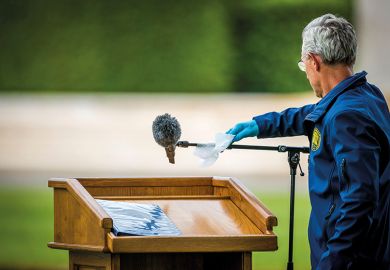There is a meme on social media you might be familiar with, which presents two pictures side by side under the heading: “How it started. How it’s going.”
The idea is to poke fun at things having gone horribly wrong – ideally for one’s political opponents.
Playing this game with Times Higher Education covers, we could pick one from four years ago featuring Donald Trump and Nigel Farage as two halves of the same man in the ascendancy, and contrast it with our cover ahead of the recent US election, when Joe Biden’s election marked a return to some normality.
How it started, how it’s going. Except, like most things on social media, it is not that simple.
Trump stumbled out of the White House this week in disgrace, but also as the man who received more votes in November than any other presidential candidate in history – bar his victor.
That many of the problems that swept him to power in 2016 remain, or have got worse, during his tenure is an irony that appears lost on those voters, but that does not help Biden and his administration, who have a hell of a clean-up job on their hands.
Universities will be crucial to addressing those issues, from remedying economic inequality to shoring up the underpinnings of democracy. But what does that really mean in those areas that have felt most disenfranchised by the change in economic realities over recent decades?
In our cover story, we explore this issue from ground zero: the American Midwest, where economies and lives have been hollowed out by deindustrialisation.
This grim reality, ignored for too long, helped to fuel the rise of populism, nationalism and the malign influence that conspiracy theorists have managed to develop in the West in particular.
This has happened even as participation rates in higher education have grown – at face value a somewhat strange confluence of factors, but not when one understands that the issues at play are fundamentally about inequality: the gulf that those left behind see growing year by year, and who, in the words of one commentator, “can’t understand what is happening to them and don’t feel they deserve it”.
This, and the response now required, raises the question of who universities are for: are they for those who attend them (let’s call this the Alumni First perspective), or are they for the whole of society?
In many respects, they do deliver great benefits for all. Many universities now explicitly embrace their civic agenda, and all who conduct research do so for the greater good. In the past year, there have been clear examples of what this looks like: the Covid-19 vaccine developed at the University of Oxford is a great case study, particularly in light of the university’s insistence that it be provided to the whole world on a non-profit basis for the duration of the pandemic.
But our cover story asks what more they can do within regions that have been economically ravaged. President Biden is promising to channel huge investment into innovation, just as in the UK the government has promised to focus on science and technology to fire its levelling-up agenda.
So how does this translate for working-class people left with little or nothing by the hollowing-out of former industrial heartlands? Can research and innovation spending centred on universities result in jobs for all sections of society?
As Timothy Killeen, president of the University of Illinois System, puts it: “The world needs a new model of innovation that doesn’t just create [social] gaps; we need to be able to lift society up.”
Our feature explores new structures that might help to make this a reality, including a greater role for interstate collaboration in the US, where the commentator Richard Longworth has argued that universities have a particular role to play in building regional industries.
The affordability of higher education will be crucial if the expansion of participation is to address the deep divides that exist in society, but cost alone will not reassure the “have-nots” that they have a place on campus, and a university-led economic recovery that includes everyone could have an even greater impact.
The arrival of President Biden and his wife, Jill, a community college lecturer, will at the very least bring back to the White House an understanding of both. It’s a start.
POSTSCRIPT:
Print headline: To bind the nation’s wounds
Register to continue
Why register?
- Registration is free and only takes a moment
- Once registered, you can read 3 articles a month
- Sign up for our newsletter
Subscribe
Or subscribe for unlimited access to:
- Unlimited access to news, views, insights & reviews
- Digital editions
- Digital access to THE’s university and college rankings analysis
Already registered or a current subscriber? Login




